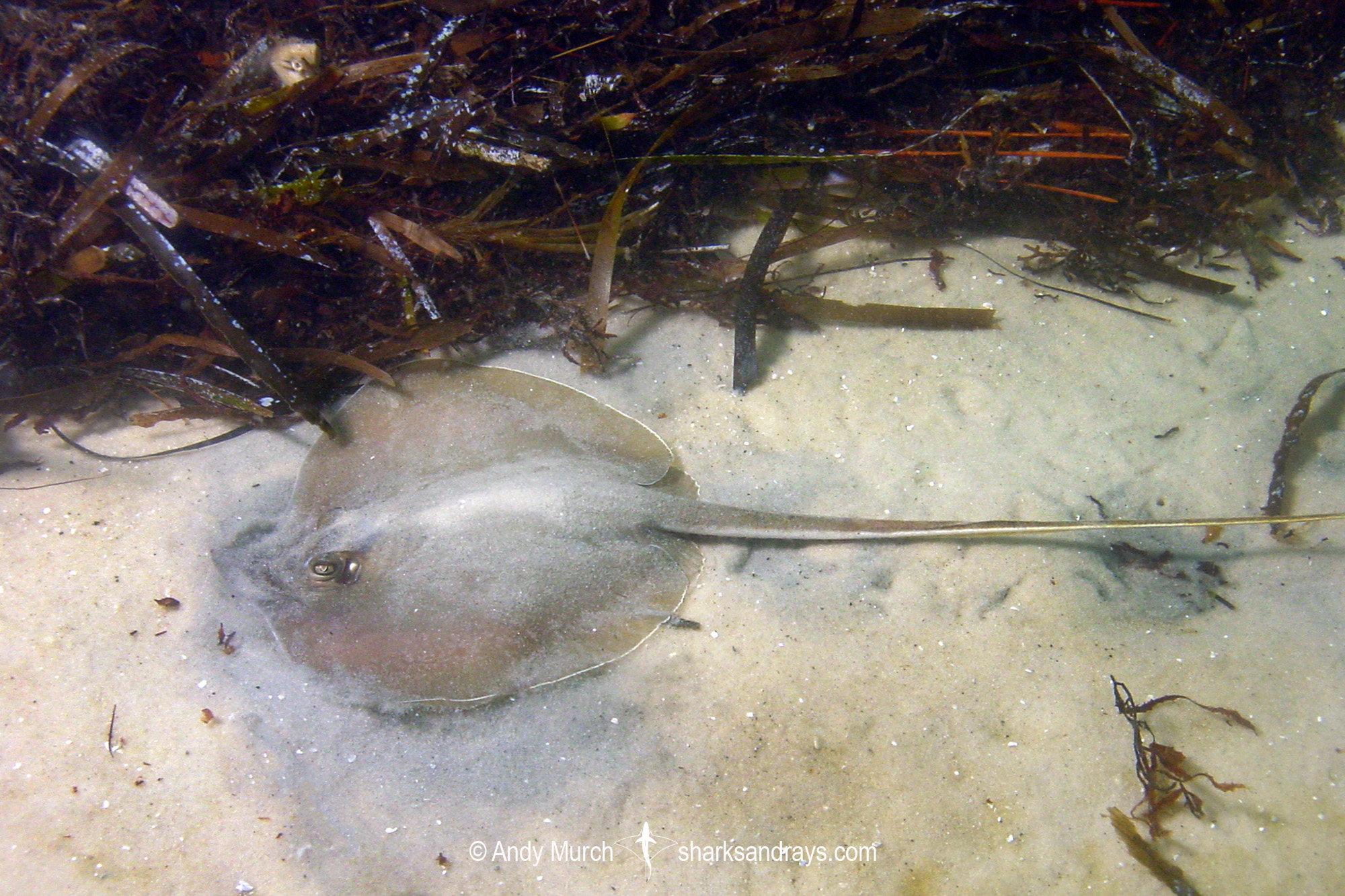Common name(s)
Atlantic Stingray.
Identification
A small stingray with a vaguely heart-shaped disc. Disc width approximately equal to length. Anterior margins of disc concave. Pectoral fin apices broadly rounded. Pelvic fins large with tightly rounded apices.
Eyes large. Snout angular and elongated. Snout length 1.9-2.6 x combined eye and spiracle length.
Mouth with 3 large oral papillae. Shallow labial furrows around mouth. Lower jaw weakly arched. Nasal curtain split centrally, with weakly fringed posterior margins. Nostrils thin, positioned obliquely.
No dermal denticles present in young. Adults have a denticle band between eyes and mid disc. Row of thorns present along midline from nape to caudal sting. 1-2 thorns on each shoulder. Tail tapers gently to caudal sting, then whiplike or filamentous to tip. Tail length (when intact) approximately 1.7-1.8 x disc width. Ventral finfold long; depth slightly more than tail height beyond caudal sting. Dorsal finfold short but prominent. 1 or 2 slender caudal stings usually present.
Colour
Dorsum reddish-brown or tan; sometimes with pinkish hues. Colour paler towards disc margin. Ventrum white, sometimes with a dusky disc margin. Tail towards tip often dusky. Ventral finfold brownish.
Size
Maximum disc width 45cm. Disc width at birth 10-13cm.
Habitat
Tropical to warm-temperate water. On sandy or muddy substrates in shallow bays, rivers, and lakes. Capable of living year round in freshwater. Intertidal to 25m.
Distribution
Western Atlantic. Found from Delaware Bay to the Yucatan Peninsula including the Gulf of Mexico. Also in freshwater river systems in Florida: Indian River Lagoon, St. Johns River, and associated lakes in central Florida.
Conservation Status
LEAST CONCERN
In the United States, Atlantic Stingray may be caught as bycatch by recreational anglers where it is likely killed due to the danger of its spine, however, the level of mortality is likely low. American stingray is caught as bycatch in artisanal shrimp trawl fisheries in southern Mexico but generally discarded alive (J.C. Pérez-Jiménez unpubl. data 2019). There is the potential for habitat loss due to tourism and coastal development in the Quintana Roo region of Mexico (M.P. Blanco-Parra unpubl. data 2019).
Citation
Carlson, J., Charvet, P., Blanco-Parra, MP, Briones Bell-lloch, A., Cardenosa, D., Derrick, D., Espinoza, E., Furtado, M., Morales-Saldaña, J.M., Naranjo-Elizondo, B., Pacoureau, N., Rosa, R., Schneider, E.V.C. & Simpson, N.J. 2020. Hypanus sabinus. The IUCN Red List of Threatened Species 2020: e.T60158A124445557. https://dx.doi.org/10.2305/IUCN.UK.2020-3.RLTS.T60158A124445557.en. Downloaded on 20 February 2021.
Reproduction
Matrotrophic aplacental viviparity. 2-3 pups per litter. Gestation approximately 4 months.
Diet
Diet consists mainly of marine worms and crustaceans.
Behavior
Sedentary. Excavates holes in the sand while searching for prey.
Reaction to divers
Fairly tolerant if not approached too closely.
Diving logistics
Atlantic Stingrays can often be found at the Jetty at St. Andrews State Recreation Area at Panama City, Florida. It is possible to snorkel with them or dive but I found them mainly in the 2-5m depth range, so tanks are not really necessary. Air fills can be obtained from Panama City Dive Centre near the entrance to the park.
Two options are to dive the beach on the right side of the rock jetty or swim through the sheltered swimming area and drop into the channel. Make sure you have an incoming tide for clarity and to avoid being swept out into the bay. This is a great area to find rays. On one visit, I encountered Southern stingrays, Bluntnose Stingrays, and a school of around 25 Atlantic mobula rays.
I have also looked for this species unsuccessfully while snorkelling in St Johns River System in Central Florida. However, there are reports of snorkelers encountering Atlantic stingrays in that area.
What’s new
View our full list of updates
Similar species
Southern Stingray Distinguished by larger size and much shorter, more obtusely angular snout.








